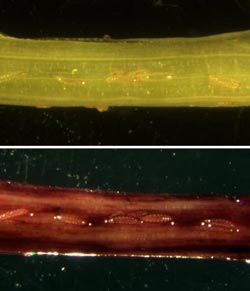Salivating over wheat plants may net Hessian flies big meal or death

A Hessian fly-infested susceptible wheat seedling before (top) and after (bottom) staining with red dye. The larvae induce the host plant cells to increase in permeability, as visualized by their ability to absorb the red stain. This increased permeability allows plant nutrients to leak to the surface where they are consumed by the larvae. Credit: Photo by Jill Nemacheck<br>
“The insect induces or suppresses susceptibility in the plant,” said Christie Williams, a research scientist with the U.S. Department of Agriculture's Agricultural Research Service and a Purdue associate professor of entomology. “It's not that the fly larva is making holes and retrieving nutrients as once thought. The larva is doing something chemically to change the plant.”
Williams and a team of entomologists found that Hessian flies, which cause millions of dollars in damage to U.S. wheat crops each year, trigger one of two responses in plants: the plants either put up strong defenses to essentially starve the fly or succumb, releasing essential nutrients to the fly. Their findings were published in the early online release of the Journal of Experimental Botany.
“At about the first day of attack, when susceptible plants become permeable, they start to secrete nutrients that the larvae consume,” said Jill Nemacheck, a USDA/ARS biological sciences technician at Purdue and paper co-author. “In resistant plants, that permeability goes away because the plant does its job quickly and releases proteins that make the larva not want to feed.”
The researchers applied a red dye to the plant's surface and observed how far it spread throughout plant tissues. In plants that mounted defenses, the dye spread minimally and tissue repaired itself within a few days. In plants that were susceptible, the dye spread throughout the plant before it died.
“It's a simple way to visually observe how the tissue is affected,” said Kurt Saltzmann, a Purdue research assistant professor of molecular entomology and co-author of the paper. “It's one of those things you can see immediately.”
Researchers saw signs that resistant plants were producing more lipase, a protein that degrades lipids, or fats, in the cell surface. It is believed that lipase acts as a defense by providing the small surface holes that deliver toxic proteins to deter larvae from feeding.
In an unexpected twist, however, the researchers found cases in which avirulent fly larvae, which should trigger defense mechanisms from the plants that lead to the larvae deaths, could survive in some cases. A virulent larva that attacks a resistant plant that has already initiated defense mechanisms can reverse those defenses. In that case, both the virulent and avirulent flies would be able to feed on the plant.
“By having this rescue happen, it keeps some avirulent flies in the population,” Williams said. “This may be an advantage to the plant to some degree. It probably extends the durability of resistance.”
The next step in the research is to determine which genes are responsible for turning on wheat defenses and how those could be activated to respond to virulent flies.
“We need to better understand the mechanisms that occur when a virulent larva infests a host plant in order to build better defenses for those plants,” said Subhashree Subramanyam, a research associate in agronomy and paper co-author.
The U.S. Department of Agriculture-Agricultural Research Service funded the research.
A publication-quality photo is available at http://www.purdue.edu/uns/images/2011/williams-hessian.jpg
Abstract on the research in this release is available at: http://www.purdue.edu/newsroom/research/2011/110614WilliamsPermeablili.html
Media Contact
More Information:
http://www.purdue.eduAll latest news from the category: Agricultural and Forestry Science
Newest articles

Nerve cells of blind mice retain their visual function
Nerve cells in the retina were analysed at TU Wien (Vienna) using microelectrodes. They show astonishingly stable behavior – good news for retina implants. The retina is often referred to…

State-wide center for quantum science
Karlsruhe Institute of Technology joins IQST as a new partner. The mission of IQST is to further our understanding of nature and develop innovative technologies based on quantum science by…

Newly designed nanomaterial
…shows promise as antimicrobial agent. Rice scientists develop nanocrystals that kill bacteria under visible light. Newly developed halide perovskite nanocrystals (HPNCs) show potential as antimicrobial agents that are stable, effective…



